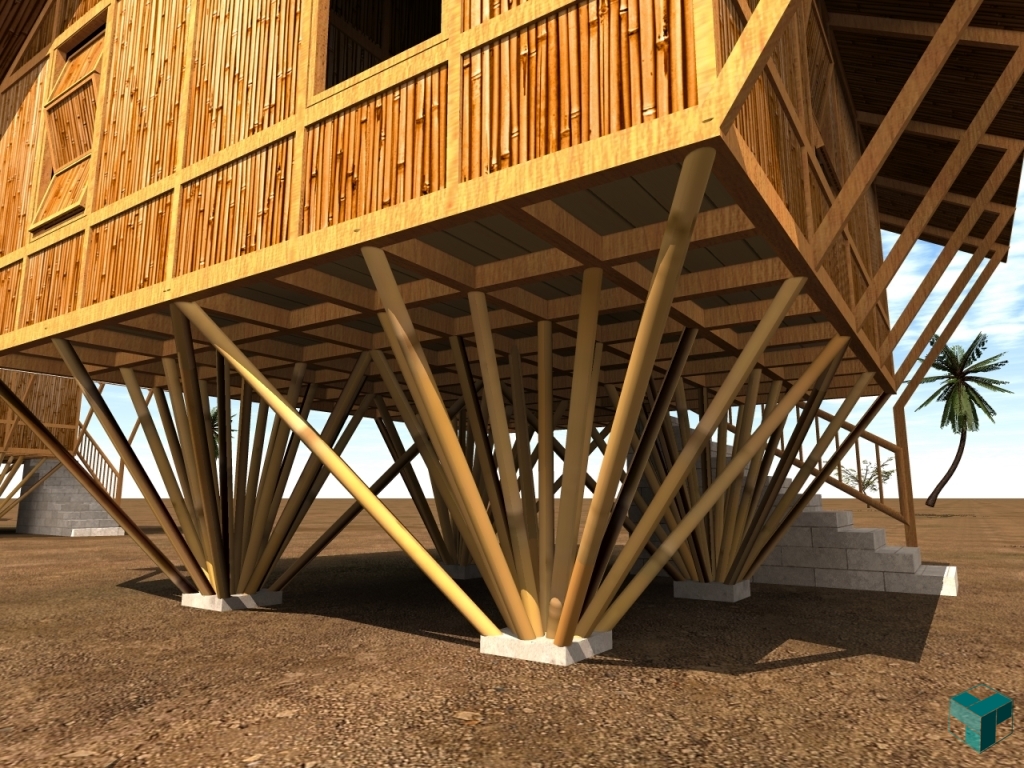the mangrove
home on stilts
A competition organized by the Kenya Red Cross in Association with the Architects Association of Kenya to design an affordable, resilient family house, putting in consideration the availability of materials, the extreme hot and dry weather to sudden flash flooding.
Location and Soil Properties: Tana Delta, Tana River County Kenya. X – Coordinates: 40.5264518, Y – Coordinates: -2.52843333, 8M Above Sea Level. Soil is Very Poorly Drained, 0.8M in Soil Depth and 1% Slope with good surface drainage.
Brief: Living Room, Kitchen, 2 No. Bedrooms, 1 washroom
Climate: Rainfall 200–250 mm. Bimodal precipitation (long rains March – May shorter rains October – November) Dry seasons June – September, December – February. Average annual temperatures 22 °C to 30 °C with average annual maximum temperatures 35 °C to 38 °C.
Concepts: The mangrove tree has an adapted response to wet flooded and marshy environments, with stilt-like members that hold the shrub above water for photosynthesis and survival yet firmly anchored in the earth, standing firm and resilient against raging waters and elements. The mangrove shrubs thrive in the coastal regions as well, contextualizing the concept to the neighborhood.
The concept is adopted from nature to mimic the adaptive response by raising the house 1.5 meter high to allow flood water and surface runoff to run below the home. The use of treated bamboo, or wooden poles/stilts give the building an anchorage in the earth, on concrete column foundations that rest on the stable soil below ground. The treated bamboo or wooden poles provide excellent support and with cavities in the concrete column anchoring and brackets on the floor frames to receive the poles ensures easy replacement of the poles by even non experienced personnel.
Form and Space Development: The shape and appearance of The Home on Stilts is simple, replicable yet unique and in response to the prevailing challenges. A simple gable roof, held by timber/wooden supports cover the framed space that is held up by the stilts. The stilts hold the home above the waters and ground keeping the wooden structure away from moisture. The form generated also mimics the environment and responds to the climatic condition with a wide roof overhang for shade and the woven reed/sticks lattice wall to allow free movement of air and the coastal breeze.
The spaces are organized around the living room to give the sense of the communal sense of the Dagodie, Ogaden and Pokomo people. Housed in the structure are two bedrooms, a small kitchenette and the wet areas. As cultures get more modernized the need to incorporate contemporary features in rural homes becomes more dire as the levels of hygiene are put in consideration for households to have washrooms and running water. The proposal also budgets for a 3,000 liter water tank that collects rainwater or refilled from the community source. The space below the floor could be used to keep the small domestic animals for both their economic and subsistence use as is the culture of the people of Tana Delta.
Material science, justification and sustainability:
- Reinforced concrete foundation column for the substructure. Can easily be done with minimal skill and on site with materials that are readily available countrywide.
- Bamboo/ Wooden poles for support stilts. With the structural capability enhanced by the numbers, they are cheap, sustainable, available and easily replaceable.
- Timber/ wooden frame superstructure. With it’s light yet strong structural capability, timber proves to be best fit for the home on stilts. The floor, walls and roof are supported by the timber frames.
- Since the home is elevated 1,500mm above ground, stacked masonry stones form the steps in, with balustrades made of poles/bamboo. The availability of masonry stones and ease in use, strength and resistance to wear and tear make it ideal for the steps to the home.
- The floor is wooden for its light and strong component and its insulative property keeping the home cool in hot climate.
- The walls (except the wet areas) have a sticks/reed lattice work that is light, readily available and easy to fabricate. The lattice work makes the home breathable in the hot climate with the coastal breeze permeating the walls keeping the interior cool.
- The wet areas have tiling to waterproof against any moisture to the timber structure and walls.
- The galvanized roof is readily available, light and its reflective character reflects heat and sun out of the home. The wide eave overhangs to keep the sun from the walls and the interior of the house keeping it cool.












